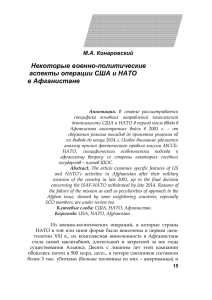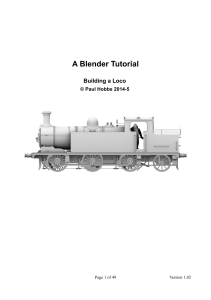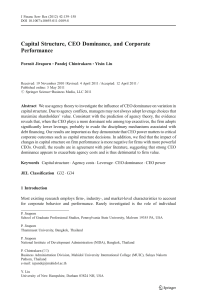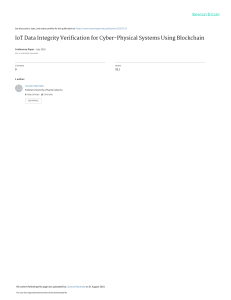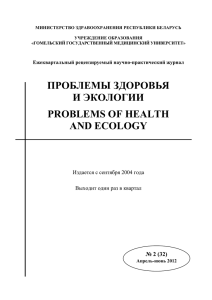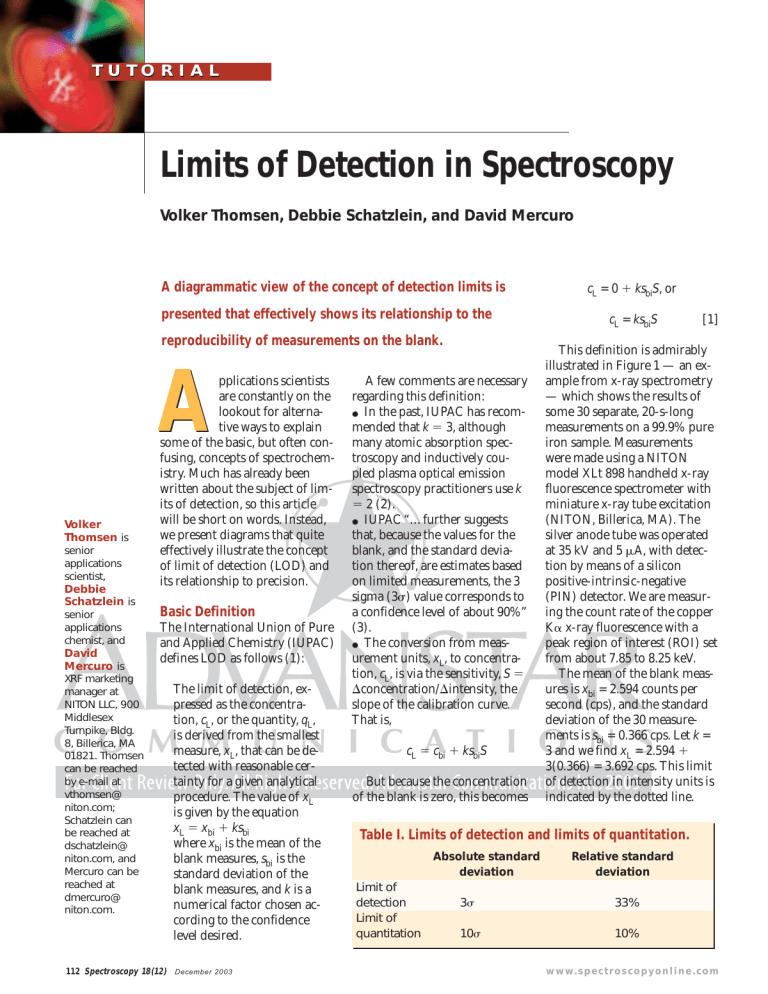
TUTOR IAL Limits of Detection in Spectroscopy Volker Thomsen, Debbie Schatzlein, and David Mercuro A diagrammatic view of the concept of detection limits is presented that effectively shows its relationship to the reproducibility of measurements on the blank. A Volker Thomsen is senior applications scientist, Debbie Schatzlein is senior applications chemist, and David Mercuro is pplications scientists are constantly on the lookout for alternative ways to explain some of the basic, but often confusing, concepts of spectrochemistry. Much has already been written about the subject of limits of detection, so this article will be short on words. Instead, we present diagrams that quite effectively illustrate the concept of limit of detection (LOD) and its relationship to precision. Basic Definition The International Union of Pure and Applied Chemistry (IUPAC) defines LOD as follows (1): XRF marketing manager at NITON LLC, 900 Middlesex Turnpike, Bldg. 8, Billerica, MA 01821. Thomsen can be reached by e-mail at vthomsen@ niton.com; Schatzlein can be reached at dschatzlein@ niton.com, and Mercuro can be reached at dmercuro@ niton.com. 112 Spectroscopy 18(12) The limit of detection, expressed as the concentration, cL, or the quantity, qL, is derived from the smallest measure, xL, that can be detected with reasonable certainty for a given analytical procedure. The value of xL is given by the equation xL xbi ksbi where xbi is the mean of the blank measures, sbi is the standard deviation of the blank measures, and k is a numerical factor chosen according to the confidence level desired. December 2003 A few comments are necessary regarding this definition: ● In the past, IUPAC has recommended that k 3, although many atomic absorption spectroscopy and inductively coupled plasma optical emission spectroscopy practitioners use k 2 (2). ● IUPAC “…further suggests that, because the values for the blank, and the standard deviation thereof, are estimates based on limited measurements, the 3 sigma (3) value corresponds to a confidence level of about 90%” (3). ● The conversion from measurement units, xL, to concentration, cL, is via the sensitivity, S concentration/intensity, the slope of the calibration curve. That is, cL cbi ksbiS But because the concentration of the blank is zero, this becomes cL = 0 ksbiS, or cL = ksbiS [1] This definition is admirably illustrated in Figure 1 — an example from x-ray spectrometry — which shows the results of some 30 separate, 20-s-long measurements on a 99.9% pure iron sample. Measurements were made using a NITON model XLt 898 handheld x-ray fluorescence spectrometer with miniature x-ray tube excitation (NITON, Billerica, MA). The silver anode tube was operated at 35 kV and 5 A, with detection by means of a silicon positive-intrinsic-negative (PIN) detector. We are measuring the count rate of the copper K x-ray fluorescence with a peak region of interest (ROI) set from about 7.85 to 8.25 keV. The mean of the blank measures is xbi = 2.594 counts per second (cps), and the standard deviation of the 30 measurements is sbi = 0.366 cps. Let k = 3 and we find xL = 2.594 3(0.366) = 3.692 cps. This limit of detection in intensity units is indicated by the dotted line. Table I. Limits of detection and limits of quantitation. Absolute standard deviation Limit of detection Limit of quantitation Relative standard deviation 3 33% 10 10% w w w. s p e c t r o s c o p y o n l i n e . c o m Tutorial 5 Pure Fe: blank Average blank Limit of detection 7 4 5 3 Count rate (cps) Count rate (cps) 6 2 1 4 3 2 1 0 0 0 4 8 12 16 20 24 0 4 28 8 12 16 20 Measurement number 24 28 Measurement number Figure 1. Replicate intensity measurements on blank. Figure 2 shows the data of Figure 1 along with 14 measurements on a lowalloyed steel (C 1⁄2Mo) with 0.202% copper. A common misconception is that the LOD is the smallest concentration that can be measured. Instead, it is the concentration at which we can decide whether an element is present or not (6) — that is, the point where we can just distinguish a signal from the background. To find the sensitivity, we note that the average of the 14 measurements is 5.325 cps copper. Thus our sensitivity is S (0.202% 0%)/(5.325 cps 2.594 cps) 0.074%/cps. Multiplying 3 of our blank and S, we arrive at a limit of detection for copper in an iron matrix of 0.08%. Figure 2. Measurements on standard along with blank measurements. This example brings up several aspects of the limit-of-detection concept. Limits of Detection and the BEC Refer back to Figure 2. Note that the net peak height is just about the same as the level of the background. But this is just the definition of the background equivalent concentration (BEC) (4–6). This provides for an alternative method of computing the LOD, using the BEC and the relative standard deviation (RSD) of the blank. cL 3 RSDblank BEC/100 [2] From the data on the blank provided above (xbi 2.594 cps and sbi 0.366 cps), we compute the RSD as 14.1%. Therefore, cL 3(14.1)(0.2%)/100 0.085%. The slight discrepancy is due to our visual estimation of the BEC. If calculated (5), the BEC is found to be 0.19% and then the two computed limits of detection become identical. Limits of Detection and Limits of Quantitation A common misconception is that the LOD is the smallest concentration that can be measured. Instead, it is the concentration at which we can decide whether an element is present or not (6) — that is, the point where we can just distinguish a signal from the background. Quantitation is generally agreed to begin at a concentration equal to 10 standard deviations of the blank. This is called the limit of quantitation (LOQ) or limit of determination. Therefore, LOQ 3.3 LOD. Thus, in the example given in Figures 1 and 2, the limit of quantitation is actually about 0.24%. Instrument Detection Limits Versus Method Detection Limits The example above provides the detection limit for copper in iron under close-to-ideal conditions, where there are few other alloying elements. This is an example of an instrument detection limit (IDL) — that is, a detection limit in a clean matrix. The method detection limit (MDL) considers real-life matrices. For example, we can expect the LOD to degrade in stainless steels containing several percent of nickel that will raise the background in the copper region of interest. A rule of thumb typically used by optical emission spectroscopists is that the MDL can be anywhere from about two to five times worse than the IDL. In many x-ray fluorescence applications, the IDLs are also typically a factor of two to three times better than the MDLs found with real-world samples. However, this rule of thumb may not necessarily apply across all spectroscopy techniques and applications. December 2003 18(12) Spectroscopy 113 Tutorial 35 Precision and the LOD 33% RSD 30 Relative standard deviation One final topic: Every practicing spectrochemist knows that as the concentration of the analyte decreases, the precision, as expressed in the relative standard deviation, gets worse. Quantitatively speaking, the RSD is 10% at the limit of quantitation and 33% at the limit of detection (k = 3 in IUPAC definition or 3 detection limits) (see Table I). 25 20 y 4.2086x0.6765 15 R2 0.9594 10 5 0 0 5 10 15 20 Concentration (%) Every practicing Figure 3. Precision vs. concentration for chromium in Ni-base superalloys. spectrochemist knows that as the concentration of the analyte decreases, the precision, as expressed in the relative standard deviation, gets worse. Figure 3 shows this relationship between concentration and precision graphically. Sixteen nickel-base alloys with varying chromium content were measured 11 times each for 20 s to gather the precision data. Measurements were made using the handheld xray fluorescence spectrometer and miniature x-ray tube excitation noted earlier. Using the equation of the leastsquares curve fit through these data points, we can extrapolate back to an RSD of 33% to find the LOD. This value agrees well with the LOD computed in the usual manner illustrated by equations 1 and 2. Of course, this very timeconsuming means of computing the LOD would rarely be used. Nevertheless it is reassuring that this alternate method produces the same result. Conclusion A picture is worth a thousand words — the diagrams presented in this tutorial should help illuminate a sometimes confusing subject. The limit of detection is related to the reproducibility of the spectral back- ground and the instrument sensitivity. It is found by three times the standard deviation repeated measurements of the blank times the sensitivity, as determined by measurement(s) of a standard. References 1. IUPAC Compendium of Chemical Terminology, 2nd Edition (1997). See website http://www.chemsoc.org/ chembytes/goldbook/. 2. G.L. Long and J.D. Winefordner, Anal. Chem. 55, 712A (1983). 3. J.V. Gilfrich and L.S. Birks, Anal. Chem. 56, 77 (1984). 4. P.W.J.M. Boumans, Inductively Coupled Plasma Spectroscopy — Part I, John Wiley & Sons (1987). 5. V. Thomsen, G. Roberts, and K. Burgess, Spectroscopy 15(1), 33–36 (2000). 6. R. Payling, www. thespectroscopynet.com/ Educational/detection_limit.htm. ■ Something we should know? We welcome your letters and appreciate your feedback. 114 Spectroscopy 18(12) December 2003 Circle 89 Write to: Spectroscopy 485 Route 1 South, Building F, First Floor Iselin, NJ 08830 (732) 225-9500 Fax: (732)225-0211 E-mail: [email protected] Eugene, OR 97401-6806 w w w. s p e c t r o s c o p y o n l i n e . c o m

